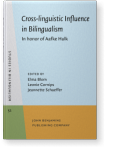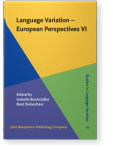Elma Blom
List of John Benjamins publications for which Elma Blom plays a role.
Journals
Book series
Titles
Cross-linguistic Influence in Bilingualism: In honor of Aafke Hulk
Edited by Elma Blom, Leonie Cornips and Jeannette Schaeffer
[Studies in Bilingualism, 52] 2017. vi, 358 pp.
Subjects Language acquisition | Multilingualism | Theoretical linguistics
Experimental Methods in Language Acquisition Research
Edited by Elma Blom and Sharon Unsworth
[Language Learning & Language Teaching, 27] 2010. vii, 292 pp.
Subjects Language acquisition | Psycholinguistics | Theoretical linguistics
2021 Crosslinguistic nonword repetition and narrative performance over time: A longitudinal study on 5- to 8-year-old children with diverse language skills Language Impairment in Multilingual Settings: LITMUS in action across Europe, Armon-Lotem, Sharon and Kleanthes K. Grohmann (eds.), pp. 301–328 | Chapter
Previous research has shown that a crosslinguistic nonword repetition and narrative tasks can support the identification of developmental language disorder (DLD) in 5- and 6-year-old bilingual children. The tasks disentangled the effects of DLD and bilingualism and demonstrated good clinical… read more
2020 Bilingual children’s lexical and narrative comprehension in Dutch as the majority language Developing Narrative Comprehension: Multilingual Assessment Instrument for Narratives, Bohnacker, Ute and Natalia Gagarina (eds.), pp. 197–230 | Chapter
Background. Some studies find that bilingual children perform below monolinguals on language measures, whereas other studies report no differences. For the purpose of this study, we investigated the Dutch lexical and narrative comprehension of bilingual Tarifit-Dutch and Turkish-Dutch children.… read more
2017 Effects of language impairment and bilingualism across domains: Vocabulary, morphology and verbal memory Language Impairment in Bilingual Children: State of the art 2017, Marinis, Theodoros, Sharon Armon-Lotem and George Pontikas (eds.), pp. 277–300 | Article
Purpose: This study examined the effects of language impairment (LI) and bilingualism across vocabulary, morphology and verbal memory in a sample of children learning Dutch. Methods: Children (MAGE = 71 months) were assigned to a monolingual group with typical development (TD) (n = 30),… read more
2017 Cross-linguistic influence in bilingualism: Festschrift for Aafke Hulk Cross-linguistic Influence in Bilingualism: In honor of Aafke Hulk, Blom, Elma, Leonie Cornips and Jeannette Schaeffer (eds.), pp. 1–14 | Chapter
2017 Inter-individual variation among young children growing up in a bidialectal community: The acquisition of dialect and standard Dutch vocabulary Language Variation - European Perspectives VI: Selected papers from the Eighth International Conference on Language Variation in Europe (ICLaVE 8), Leipzig, May 2015, Buchstaller, Isabelle and Beat Siebenhaar (eds.), pp. 85–98 | Chapter
This study focuses on the relationship between dialect use and the acquisition of standard Dutch vocabulary by young children in the Dutch province of Limburg.1 The results of a newly-developed dialect expressive vocabulary task show extensive inter-individual variation that does not support a… read more
2017 The impact of transparency and morpho-phonological cues in the acquisition of grammatical gender in sequential bilingual children and children with Specific Language Impairment: A cross-linguistic study Cross-linguistic Influence in Bilingualism: In honor of Aafke Hulk, Blom, Elma, Leonie Cornips and Jeannette Schaeffer (eds.), pp. 153–180 | Chapter
2016 The influence of phonological factors on the expression of finiteness by children learning Dutch as their first and second language Finiteness Matters: On finiteness-related phenomena in natural languages, Eide, Kristin Melum (ed.), pp. 287–308 | Article
Previous research has indicated that children learning a first language (L1) and children learning a second language (L2) make errors with finiteness marking, even when they master the syntactic and morphological properties of finiteness marking in the target language. This study investigates… read more
2011
Recent research has shown that children who learn Dutch as their second language (L2) have difficulties with Dutch grammatical gender. This study shows that six to nine year old L2 Dutch children whose first language (L1) is Turkish noticed incorrect gender agreement between determiner and noun… read more
2010 Chapter 10. Comparing L1 children, L2 children and L2 adults Experimental Methods in Language Acquisition Research, Blom, Elma and Sharon Unsworth (eds.), pp. 201–222 | Chapter
2008 Testing the Domain-by-Age Model: Inflection and placement of Dutch verbs Current Trends in Child Second Language Acquisition: A generative perspective, Haznedar, Belma and Elena Gavruseva (eds.), pp. 271–300 | Article
Generalizing over various observations on the language development of children acquiring a second language (child L2 acquisition), Schwartz (2003: 47) concludes that “in the domain of inflectional morphology, child L2 acquisition is more like child L1 acquisition, and in the domain of syntax, child… read more
2006 A constraint-based approach to morphological neutralization Linguistics in the Netherlands 2006, Weijer, Jeroen van de and Bettelou Los (eds.), pp. 78–88 | Article
2002 On the use and interpretation of root infinitives in early child Dutch Modality and its Interaction with the Verbal System, Barbiers, Sjef, Frits Beukema and Wim van der Wurff (eds.), pp. 103–131 | Article














